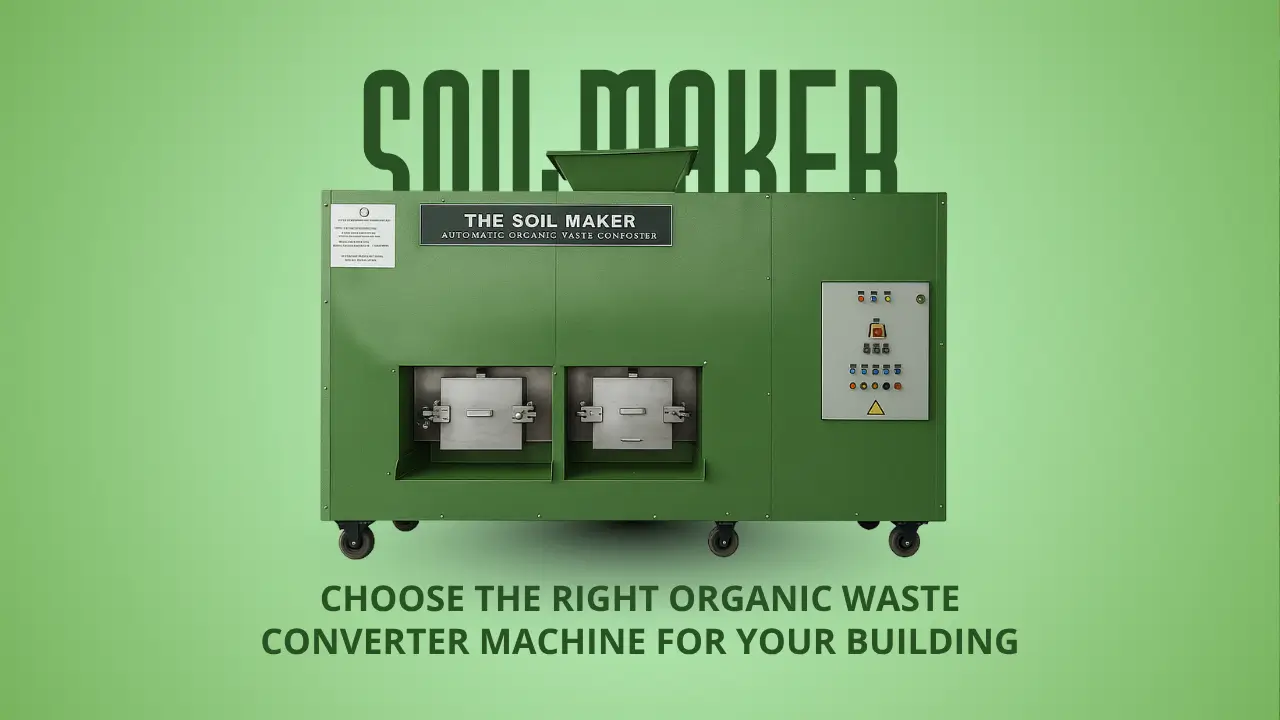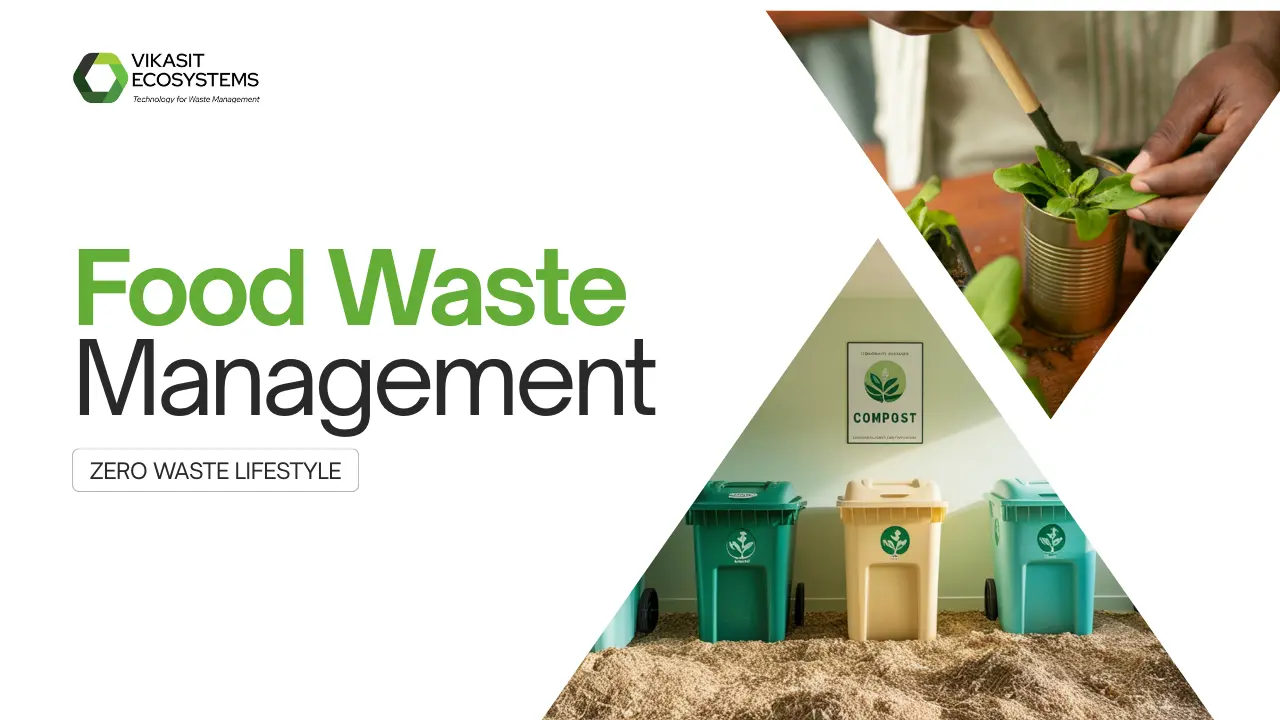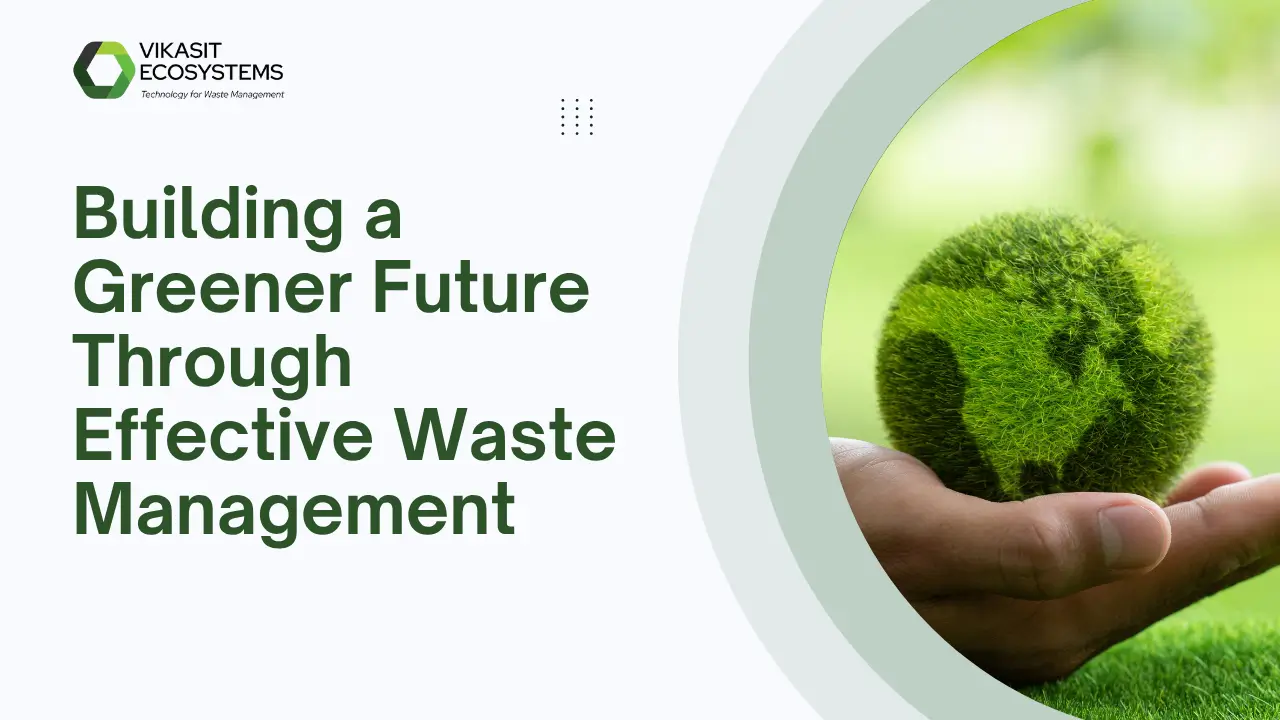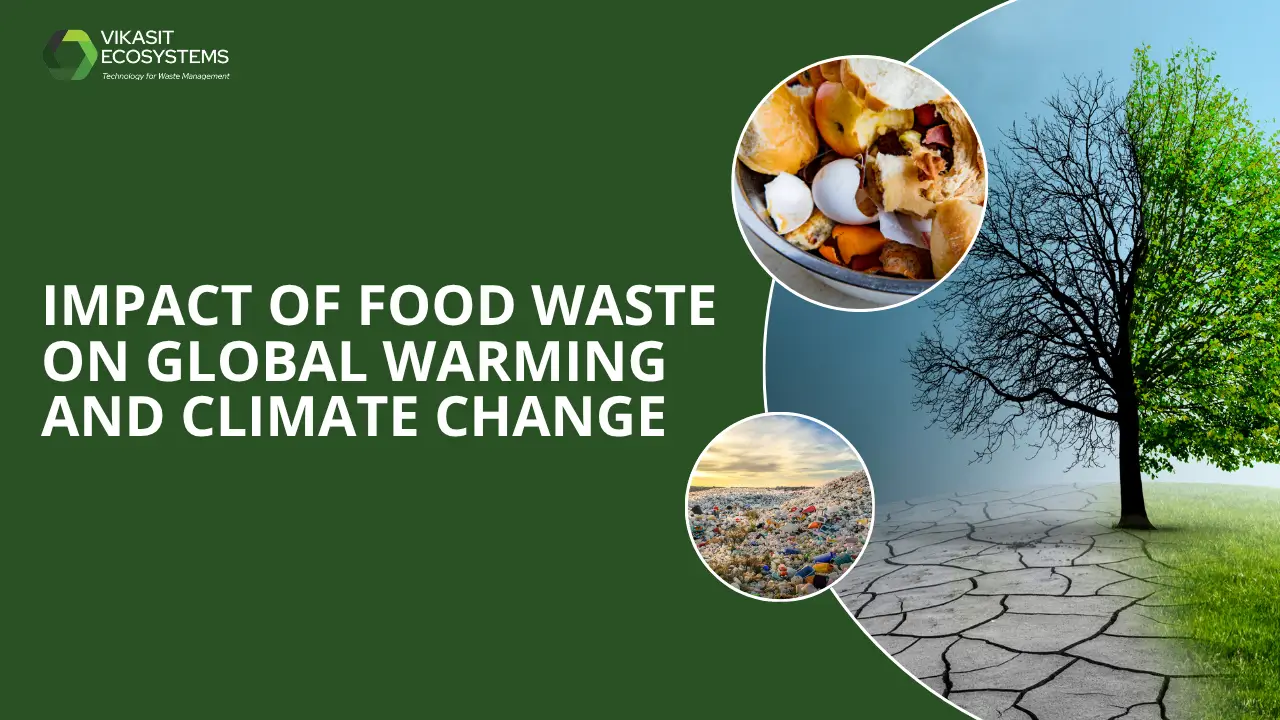Waste management is one of the biggest challenges facing modern cities. From large apartments and educational campuses to hotels, hospitals, and municipal wards, every institution struggles with how to handle growing piles of food and garden waste.
With rising awareness of sustainability and stricter municipal rules, many organizations are now adopting the organic waste converter machine (OWC) — a proven solution that converts food scraps, garden trimmings, and other biodegradable waste into nutrient-rich compost.
But here’s the catch: choosing the wrong machine leads to overflowing bins, foul odors, frustrated residents, and wasted investment. This guide will walk you through everything you need to know — from capacity calculations to key features, common mistakes, real case studies, and even a comparison of Soil Maker vs other OWC machines.
What Is an Organic Waste Converter Machine?
An organic waste converter machine (OWC) is a fully automated system that treats biodegradable waste such as food scraps, canteen leftovers, and garden trimmings. Instead of sending this waste to landfills, an OWC processes it into compost within a matter of hours.
Depending on the technology, machines take 4 to 24 hours to produce usable compost. However, our flagship product — the Soil Maker Waste Converter Machine — is engineered to deliver results in just 3 to 4 hours, regardless of waste volume.
These machines are:
- Compact and efficient – Ideal for apartments, campuses, hotels, industries, and institutions.
- Environmentally friendly – Reducing landfill burden, greenhouse gas emissions, and leachate discharge.
- Economical – Cutting waste transport costs and creating compost that can be reused or sold.
When installed in communities or institutions, they form the backbone of a decentralized waste management system.
Types of Organic Waste Converter Machines
Not all machines are the same. Depending on scale and requirements, here are few popular types:
1. Compost Bins (Aerobic Bins)
- Simple plastic or cement bins kept in a corner or basement.
- Work on natural aerobic composting with ventilation holes.
- Best for small apartments generating <20–30 kg/day.
2. Compost Tumblers
- Rotating drums placed in common areas.
- Easier aeration compared to bins — just rotate the barrel.
- Suitable for small-to-mid sized apartment waste loads (50–100 kg/day).
3. Vermicomposting (Worm Bins)
- Uses earthworms (usually red wigglers) to convert food scraps.
- Typically set up in a basement or terrace area.
- Works well in mid-sized communities if residents maintain segregation.
4. In-Vessel Organic Waste Converter Machines (Soil Maker type) 🚀
- Most common in medium-to-large apartment complexes (100+ families).
- Fully automatic system with shredder + mixer + aerobic composting chamber.
- Capacity: 50 kg/day → 2 tons/day (scalable).
Why Capacity Matters in an Organic Waste Converter Machine
The capacity of an OWC machine is the most critical factor in its effectiveness. A machine that’s too small will fail to handle the daily waste load, causing backups and odors. On the other hand, an oversized unit leads to unnecessary costs and underutilization.
Key reasons why capacity is important:
- Daily Waste Load Management – Matches your actual waste generation.
- Compliance with Municipal Rules – Many cities mandate on-site processing of a minimum percentage of waste.
- Operational Efficiency – A correctly sized machine ensures smoother operation, lower power usage, and less downtime.
- Cost Optimization – You pay only for what you need, not for wasted capacity.
How to Calculate Organic Waste Converter Machine Capacity
Choosing the right capacity starts with understanding your daily waste generation. Here’s a simple step-by-step method:
Rule of Thumb:
- Residential: 1 family ≈ 1 kg/day
- Institutions/Campuses: 1 person ≈ 0.5–0.7 kg/day
- Factories/Canteens: 1 meal ≈ 0.6–1 kg waste
Example:
- 200 families × 1 kg = 200 kg/day → Choose a 220–250 kg/day machine
- 1,000 hostel students × 0.6 kg = 600 kg/day → Choose a 700 kg/day machine
- 5,000 factory meals × 0.8 kg = 4 tons/day → Choose a 4–5 ton/day machine
Organic Waste Converter Machine Capacity Chart
🏠 Residential Apartments
| Families | Waste (kg/day) | Recommended OWC Capacity |
| 50 families | 50 kg/day | 50–60 kg/day machine |
| 100 families | 100 kg/day | 100–120 kg/day machine |
| 300 families | 300 kg/day | 300–350 kg/day machine |
| 500 families | 500 kg/day | 500–550 kg/day machine |
🏫 Institutions & Campuses
| People | Waste (kg/day) | Recommended OWC Capacity |
| 500 people | 250–350 kg/day | 300–350 kg/day machine |
| 1,000 people | 500–700 kg/day | 600–700 kg/day machine |
| 2,000 people | 1–1.4 tons/day | 1.5 ton/day machine |
🏭 Industries & Canteens
| Meals/day | Waste (kg/day) | Recommended OWC Capacity |
| 500 meals | 250–300 kg/day | 300 kg/day machine |
| 2,000 meals | 1–1.2 tons/day | 1 ton/day machine |
| 5,000 meals | 2.5–3 tons/day | 3 ton/day machine |
🏙 Municipalities & Markets
- 3–5 tons/day → Municipal wards, large markets
- 10+ tons/day → City-level composting plants
Factors to Consider Beyond Capacity
While capacity is the starting point, other factors also influence the performance and long-term suitability of an organic waste converter machine (OWC).
1. Space Availability
- Check the available area for installation.
- Machines require proper ventilation, drainage, and leachate management.
- Outdoor units should have weather protection for durability.
2. Power and Water Requirements
- Ensure your building or campus can support the OWC’s electrical and water needs.
- Newer models are designed for low power consumption and efficient water usage.
3. Ease of Operation
- Look for user-friendly machines with minimal manual handling.
- Features like automatic shredding, mixing, and curing save time and reduce labor costs.
4. Maintenance and Service Support
- Regular servicing ensures consistent performance and prevents breakdowns.
- Choose a vendor who provides strong after-sales support, spare parts, and AMC options.
5. Future Scalability
- Opt for modular systems that allow you to add more units as your waste volumes grow.
- This avoids costly replacements when your community expands.
6. Segregation at Source
- Success depends on residents or users properly segregating waste into wet, dry, and hazardous streams.
- Proper segregation improves machine efficiency and compost quality.
7. Handling of Garden Waste
- Many apartments, campuses, and institutions also generate garden/landscape waste such as leaves, branches, and trimmings.
- Ensure your OWC machine can handle garden waste directly, or pair it with a shredder to process bulky material before composting.
- Proper integration of food + garden waste management leads to higher compost yield and reduces landfill burden.
Investing in an organic waste converter machine is not just about compliance—it’s about long-term savings.
- Cost Range: Machines can range from a few lakhs for small models to ₹20–30 lakhs for large-scale units.
- Savings:
- Reduced hauling and disposal costs.
- Lower landfill contribution fees (where applicable).
- Revenue:
- Compost produced can be sold or used in gardens and landscapes.
- Some institutions package compost as part of CSR or branding initiatives.
Typically, an OWC pays back its investment within 2–3 years for medium and large facilities.
Case Study 1: Bangalore Housing Society
A 300-unit apartment complex in Bangalore generates about 300 kg of organic waste daily and 200kg of garden waste. After evaluating options, they chose a 500 kg/day organic waste converter machine.
Results:
- Saved nearly ₹2 lakhs annually in waste hauling costs.
- Produced 5–6 tons of compost monthly, used in landscaping and gifted to residents.
- Improved community participation in segregation, leading to cleaner premises.
Case Study 2: Municipal Vendor (1 Ton/Day)
- Municipal vendor handling 1 ton/day waste
- Installed a fully automatic Soil Maker with shredder & conveyor
- Results: Smooth continuous processing, odor-free operation, low electricity cost, 100% compliance with local waste rules.
Soil Maker vs Other OWC Machines
| Type Of Technology | Traditional Pit Composting/ Vermi Composting/ Bin Composting | Tank/ BIN Composting | Semi-Automatic | 24 Hr Composters | VIKASIT’s OWC – THE SOIL MAKER |
|---|---|---|---|---|---|
| Time for Processing | Approx 21-45 days | Approx 7-30 days | Approx. 15 min processing and 2-3 weeks curing | Approx 24 hour | Approx 3-4 hours |
| Process Type | At the simplest level, this process consists of making a heap of organic matter, or else layering it in a pit/Bin and waiting for the materials to break down into humus after a period of weeks or months. | The waste is added daily to the metal or plastic tank in which the decomposition process is speeded up through the shredding of the material beforehand and the addition of bacteria. Tank may or may not be heated. | Waste is shredded in the machine and after around 15 min of processing, the waste is put in racks to cure. Some kind of bacteria is added and there is usually some kids of water sprinkler system or system of aeration that is employed to bring about the finished compost in 2-3 weeks. | Chamber is heated to 80–150 degrees (anaerobic process) & waste is burned reducing the volume by 80–90%. | A Completely Natural Bio-Mechanical process. The Machine facilitates the Aerobic Composting by maintaining the correct Temperature and Air Moisture conditions to ensure Fast Composting. |
| Manpower Requirement | Labor Intensive – Regular turning, changing of Bins, etc. Labor intensive process. | Shredding of material and then loading and unloading – Regular intervention | Shredding time, unloading into crates, aeration, sprinkling with water/Bioculture, etc. Labour intensive process | Shredding of material and then loading and unloading | 60 mins total per day – loading and unloading |
| Space Required | 800-1200 Sqft for 100 Kgs/ Day | 800-1000 Sqft for 100 Kgs/ Day | 500 Sqft for 100 Kgs/ Day | 150 Sqft for 100 Kgs/ Day | 60 Sqft for 100 Kgs/ Day |
| Electricity Consumption | NA | NA | 5-8 Units | 25-30 Units/ Day | 3-4 Units/ Day |
| ROI Expectation | NA | NA | 3-5 Years | High Operational Cost/ Low Output | 2-3 Years |
| Output Usability | GOOD – Organic Content | GOOD – Organic Content | GOOD – Organic Content | Not Good – Sometimes Harmful | GOOD – Organic Content |
Common Mistakes to Avoid
1. Underestimating Waste Volume
- Always calculate your daily waste correctly and add a 10–15% buffer for peak days.
- An undersized machine quickly becomes ineffective.
2. Ignoring Segregation Practices
- OWC machines fail if fed with mixed waste.
- Proper segregation of wet, dry, and garden waste at the source is essential.
3. Not Planning for Maintenance
- Neglected machines can lead to odor, pests, and hygiene issues.
- Always factor in regular servicing and AMC support.
4. Focusing Only on Cost
- Cheap machines without reliable service or technology may break down, emit odor, or produce poor compost.
- Long-term costs are higher if service support is weak.
Buying Tips: What to Look for in an OWC Machine
When selecting an organic waste converter machine, keep these features in mind:
- Anaerobic process, not burning – Avoid burning-based systems that emit harmful gases and produce poor-quality compost. Choose machines that follow natural decomposition.
- Fast processing time – Our Soil Maker OWC machine processes waste in just 3–4 hours, the fastest in the market.
- Low power consumption – Energy-efficient models like Soil Maker use only 3–4 units of electricity per cycle, reducing operational costs.
- Compact size – Smaller, modular machines are easier to install and operate in apartments, campuses, and institutions.
- Odor-free operation – A good OWC machine should process waste without leachate discharge or foul smell.
- High-quality compost output – The compost should be nutrient-rich, ready to use in gardens, landscaping, or farming.
- Fully automatic system – For convenience, safety, and reliability, ensure the machine requires minimal manual handling.
FAQ
What is an organic waste converter machine?
An OWC is a machine that converts food and garden waste into compost within hours, reducing landfill load and producing usable organic fertilizer.
How do I calculate the right OWC capacity?
Estimate 1 kg per family/day, 0.5–0.7 kg per person in hostels, or ~0.8 kg per meal in canteens. Add 10–15% buffer.
How much does an OWC machine cost?
Prices range from ₹3 lakhs for small models to ₹30 lakhs+ for large-scale municipal units.
How fast is the Soil Maker compared to other machines?
Soil Maker converts waste into compost in 3–4 hours, while most machines take 8–24 hours.
Can an OWC handle garden waste?
Yes — with built-in shredders or add-ons. Soil Maker handles food + garden waste together efficiently.
What is the ROI for installing an OWC?
Most communities recover costs within 2–3 years through savings in waste hauling, compost reuse, and compliance benefits.
Conclusion
Choosing the right organic waste converter machine is a strategic decision for any building, campus, industry, or municipal body. By calculating your daily waste generation, considering capacity, and focusing on efficiency, you can turn waste into a valuable resource.
With its fast processing, low power use, odor-free compost, and fully automatic design, the Soil Maker OWC machine sets the benchmark for reliable and sustainable waste management.
Whether you manage a housing society, campus, factory, or municipal ward — investing in the right machine ensures savings, compliance, and a greener planet.

Written by the Sustainability Research Team at Vikasit Ecosystems – pioneers in decentralized organic waste management and creators of The Soil Maker. Follow us for updates on green innovations, circular economy, and urban resilience.





